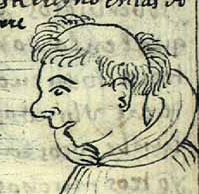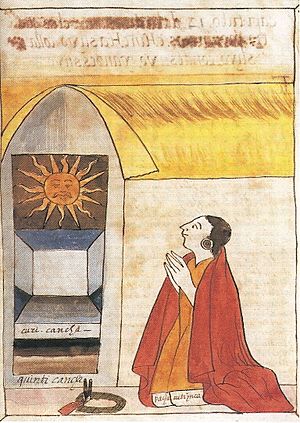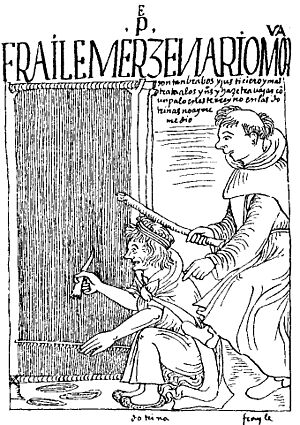Martín de Murúa facts for kids

Martín de Murúa (born around 1525 in Gipuzkoa, Spain – died around 1618 in Spain) was a Basque friar. He was also a chronicler, meaning he wrote down historical events, especially about the Spanish conquest of the Americas. He is most famous for his book Historia general del Piru (written between 1580 and 1616). This book is thought to be the first illustrated history of Peru.
Contents
Murúa's time in Peru
Murúa chose to work as a missionary in New Spain. His leaders sent him to Peru in the early 1580s. He lived in the Curahuasi Valley around that time. Later, he traveled across the Viceroyalty of Peru as a missionary. He worked near Lake Titicaca and Cuzco. This helped him learn a lot about the people who used to live in the Inca Empire. From about 1595 to 1601, he lived at the Mercedarian Monastery in Arequipa.
While doing his missionary work, Murúa also collected information to write a history of the ancient Andes. An Inca nobleman named Felipe Guamán Poma de Ayala (also known as Guamán Poma) helped him. Guamán Poma translated information from the Quechua language. He also drew over 100 pictures for the book, which are very important for history. However, Guamán Poma later wrote his own books and criticized how Murúa described Inca history.
In 1611, Murúa decided to go back to Spain. He did not take the usual route through Panama. Instead, he traveled through the Amazon Forest and crossed the Andes mountains. He arrived in La Plata and stayed there for a long time. From there, he went to Potosí and then to the Tucumán region. Along his journey, he asked local religious and government leaders to review his work. He wanted their comments and corrections. He eventually passed through Córdoba and arrived in Buenos Aires. From there, he sailed to Spain in 1615.
The next year, while living in Madrid, Murúa got permission to publish his book. Both his religious order and the king approved it. The book was called Historia general del Piru. It covered Peru's history before the Spanish arrived (called pre-Columbian history) and the early years of Spanish rule.
The Galvin and Getty manuscripts

There are two main versions of Murúa's Historia general del Piru. One is called the Galvin Murúa (or "Loyola Murúa"). The other is the Getty Murúa (or "Wellington Murúa"). The Galvin Murúa is kept in a private collection in Ireland. The Getty Murúa is at the Getty Research Institute in Los Angeles, California. You can see the original Galvin Murúa and a copy of it at the Getty Center.
The Galvin Murúa was created in the 1580s and finished around 1600. Murúa put this first version together in Peru. He had help from local writers and Indigenous artists, including Felipe Guaman Poma de Ayala. By the 1700s, the Galvin Murúa was owned by a Jesuit college in Alcalá de Henares, Spain. Later, it was housed in France. Because of its connection to the Jesuits, it was called the "Loyola Murúa." In the 1950s, a book dealer bought it and sold it to John Galvin. His family still owns the book in County Meath, Ireland.
The Getty Murúa was made between 1615 and 1616. This was the second version of the book. Most of the text was written in Peru and what is now Bolivia. It was likely edited again in Spain. This version was approved for printing. However, for unknown reasons, it was not published in the 1600s. In Spain, a statesman named Lorenzo Ramirez de Prado got the book. After he died in 1658, it went to a library in Salamanca. In 1802, it became part of King Charles IV of Spain's private library. During a war, Arthur Wellesley, 1st Duke of Wellington got the book. This is why it was called the "Wellington Murúa." It was later sold and eventually "rediscovered" in the 1950s. In 1983, the Getty Research Institute bought it, and it became known as the "Getty Murúa."
Researchers have found that some pictures from the Galvin Murúa were moved and pasted into the Getty Murúa. Two of these pictures were by Guamán Poma. However, the Galvin Murúa still has more pictures overall. The images in both books were colored using paints, dyes, and silver from both the Americas and Europe. The Getty Research Institute paid for a detailed study of both books in 2007-2008.
Murúa's Historia general del Piru (1616)
Murúa's historical book is divided into three parts, called books. Here is the full title of his work:
The first book has 92 chapters. It talks about:
The second book has 40 chapters. It includes information about:
Finally, the third book has 31 chapters. It covers:
Murúa worked closely with the native people to write his book. He included their stories and spoken histories of Inca culture and politics. The most amazing part of his book is its many illustrations. These pictures show portraits of Inca nobles and scenes from traditional ceremonies. These images mix European and native art styles.
Murúa and Guamán Poma

There is strong proof that the writers Guamán Poma and Martín de Murúa met. They worked closely together for a while, but their partnership later ended.
For a long time, experts wondered if there was a connection between Guamán Poma's book, Nueva Corónica y Buen Gobierno, and Friar Martín de Murúa's Historia general del Piru. Many thought Guamán Poma might have helped Murúa or even co-written the book. In 1967, a study compared their writings and suggested Guamán Poma followed Murúa's work.
A research project in 2007-2008 at the Getty confirmed a direct link between Guamán Poma and Murúa. Scholars like Juan de Ossio, Thomas Cummins, and Barbara Anderson, with help from Rolena Adorno and Ivan Boserup, compared the Getty Murúa and Galvin Murúa. They proved that Murúa's book does include illustrations by Guamán Poma. They concluded that Guamán Poma was part of a team of writers and artists who worked for Murúa in Peru. Murúa's project started in the 1580s, but Guamán Poma joined as an illustrator just before 1600. These findings were shown at an exhibition and meeting at the Getty Center in October 2008.
Guamán Poma openly criticized Murúa in his own book, the Corónica. He even drew a picture of the friar hitting and kicking an Indigenous woman. This drawing is titled "The Mercedarian friar Martín de Murúa abuses his parishioners and takes justice into his own hands."
According to scholar Rolena Adorno, Guamán Poma became an author after 1600. He was very critical of Murúa's work, which he had recently illustrated. Guamán Poma felt he needed to write his own story because he thought Murúa's view was too limited. Guamán Poma wrote about Andean history even before the Inca Empire. He also gave a long and critical look at colonial society. No other writer of his time did this. Guamán Poma's art skills grew from working with Murúa. He created almost 400 drawings in his own book. His art also showed a strong critical and funny side, aimed at the unfair treatment under colonial rule. Even though they worked separately after 1600, Murúa and Guamán Poma's efforts are connected. Their talents, both alone and together, created important records of how a missionary writer and an Indigenous artist worked together in early colonial Peru.
See also
- Guamán Poma
- Inca Garcilaso de la Vega
- Diego Fernández
 In Spanish: Martín de Murúa para niños
In Spanish: Martín de Murúa para niños

